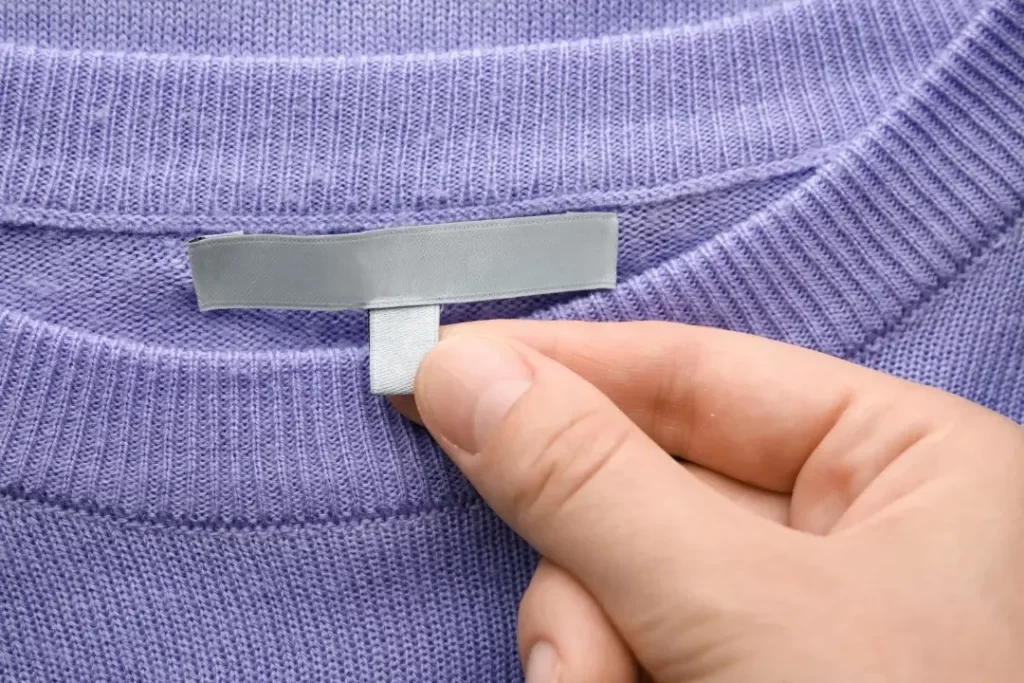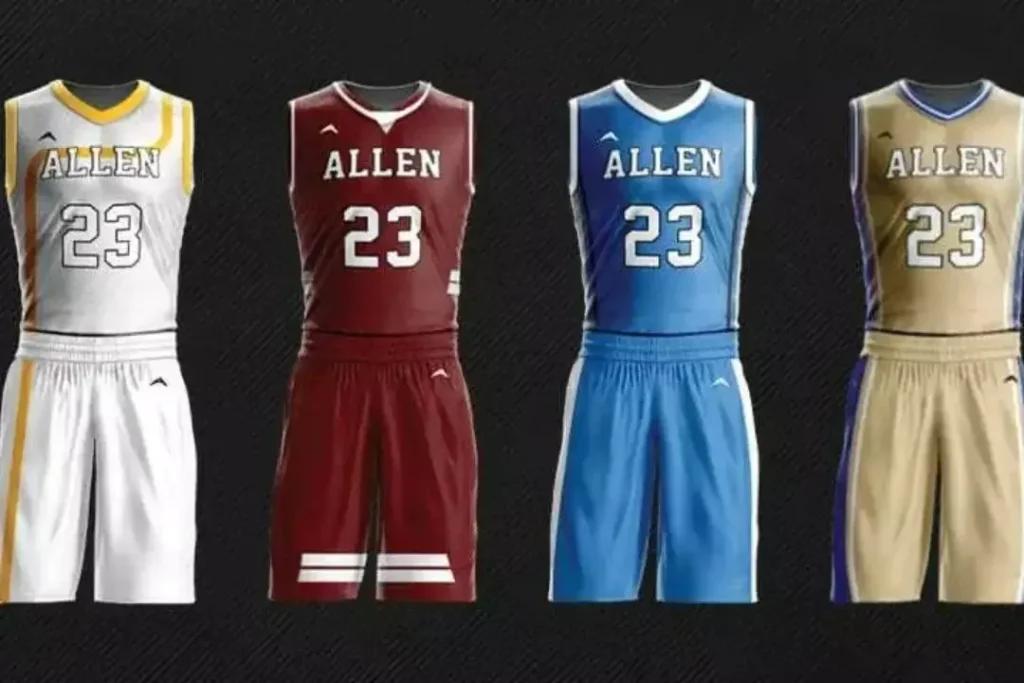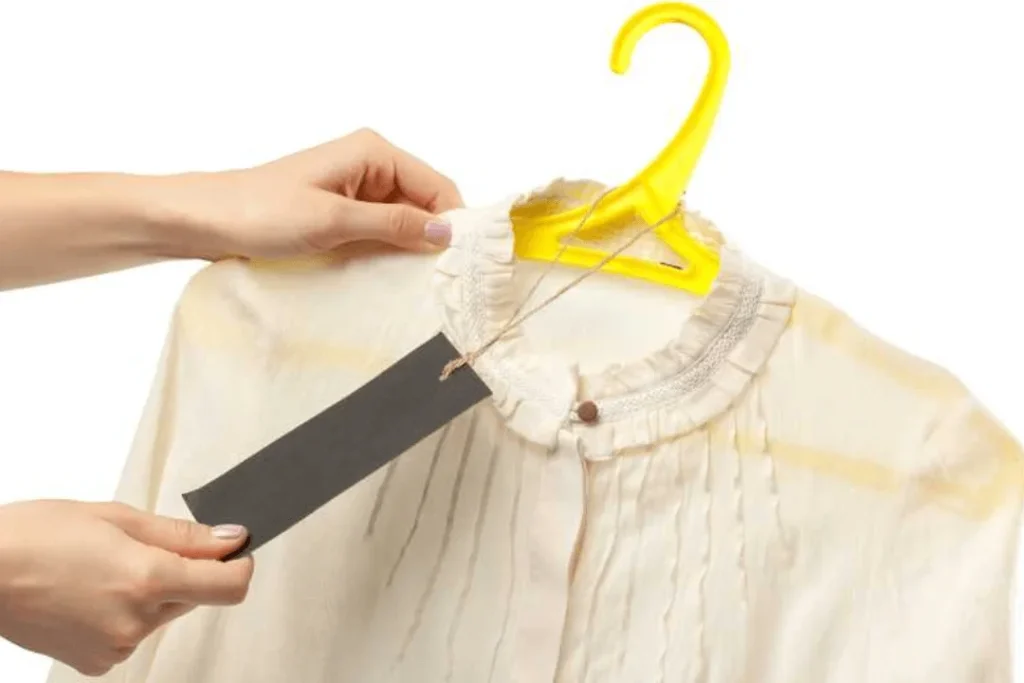
The Ultimate T-Shirt Printing Guide for Brands: 9 Types of t shirt printing - A Comprehensive Analysis of Pros, Cons, and Price Ranges to Help You Choose the Best T-Shirt Printing Method for Your Business
Dominate your industry and take your business to new heights with the perfect types of t shirt printing methods
Are you a clothing brand or startup searching for the perfect way to showcase your designs on t-shirts? Look no further than the world of t-shirt printing! With so many options available, it can be overwhelming to navigate the different types of printing and determine which is best for your business.
In this must-read guide, you will learn about how many types of t shirt printing, and we will also provide a comprehensive overview of the 11 types of t-shirt printing, including their pros and cons, price ranges, and ideal use cases. By the end of this detailed article, you’ll have all the information you need to make an informed decision about which types of t shirt printing is right for your brand.
Definition of T-Shirt Printing
But first, let’s define what t-shirt printing actually is. In short, it refers to the process of applying a design or image onto a t-shirt using a variety of methods. From screen printing to digital printing, heat transfers to embroidery, there are numerous techniques available to achieve the desired look for your t-shirts.

Importance of different types of t-shirt printing methods for Clothing Brands and Startups
So why is t-shirt printing so important for clothing brands and startups? For starters, it allows you to create unique designs that stand out in a crowded marketplace. Whether you’re looking to promote your brand, make a statement, or simply offer high-quality merchandise to your customers, t-shirt printing can help you achieve those goals.
DTG Printing
What is DTG Printing?
DTG printing, or Direct-to-Garment printing, is one of the new and innovative types of t shirt printing that allows for highly detailed designs to be printed directly onto the fabric of a t-shirt or other garment. It has become increasingly popular in recent years due to its ability to produce high-quality images with an almost unlimited number of colors.

How does DTG Printing work?
DTG printing works by using specialized inkjet technology to print designs directly onto the fabric surface of a t-shirt or other garment. The printer sprays the ink through a series of tiny nozzles, layer by layer until the final design is complete. Because the ink is absorbed directly into the fabric, rather than sitting on top of it like traditional screen printing methods, DTG printed shirts often have a softer feel and more natural look.
Pros and Cons of DTG Printing
Pros:
- High-quality prints with an almost unlimited number of colors
- Ability to produce highly detailed designs
- Soft feel and natural look of the finished product
- Quick and easy customization for small-scale production runs or one-off designs
Cons:
- Can be more expensive than other printing methods, especially for larger production runs
- Quality of the final product can depend heavily on the quality of the original design
- Not as durable as some other printing techniques
Who is DTG Printing best for?
DTG printing is an excellent choice for businesses or individuals looking to create custom, one-off designs or small-scale t-shirt production runs. It’s also great for those who want to produce high-quality, detailed t-shirt designs with an almost unlimited number of colors.
Price of DTG Printing
The cost of DTG printing can vary depending on a number of factors, including the complexity of the design and the quantity ordered. As a general estimate, you can expect to pay anywhere from $15-$30 per shirt for DTG printing services.
Indirect Screen Printing/Plastisol
What is Indirect Screen Printing/Plastisol?
Indirect screen printing, also known as transfer screen printing, involves printing the design onto a transfer paper and then transferring the design onto the fabric using heat. Plastisol is the most commonly used ink in this process, which is a synthetic polymer that is cured with heat.Learn more about plastisol click here.
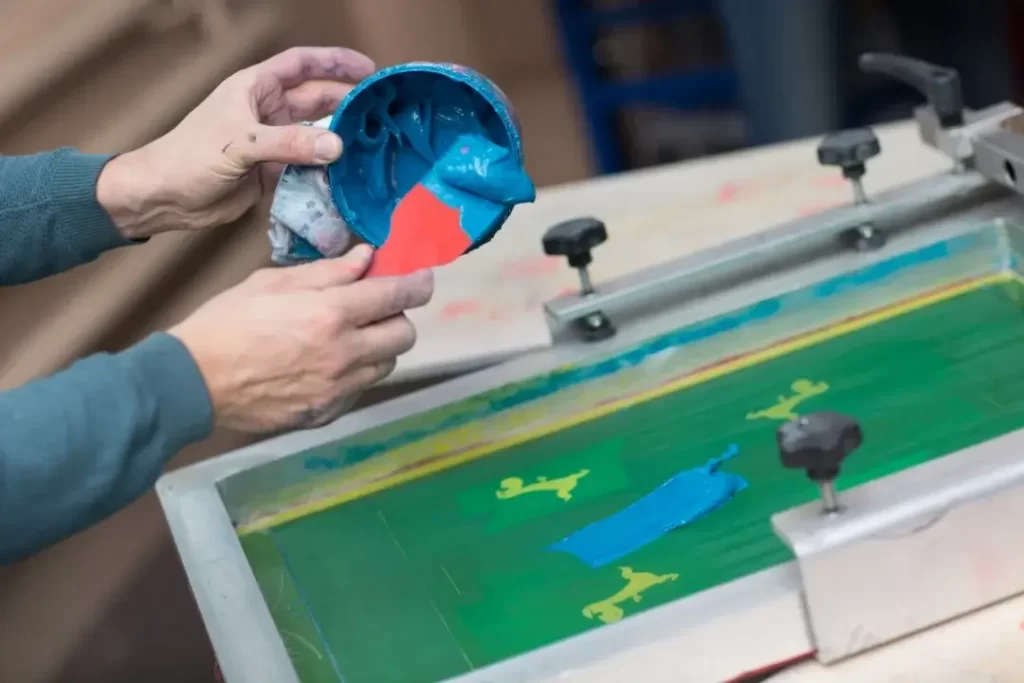
How does Indirect Screen Printing/Plastisol work?
The process of indirect screen printing involves creating a design, which is then printed onto a transfer paper using plastisol ink. Then the transfer paper is then placed onto the fabric, and heat is applied to transfer the design onto the fabric. This process creates a durable and vibrant design that is able to withstand multiple washes without fading or cracking.
Pros and Cons of Indirect Screen Printing/Plastisol
Pros:
- Great for intricate designs and detailed images
- Can print on a variety of fabrics and materials
- Durable and long-lasting design
- Consistent color and texture
- Able to produce large quantities quickly and efficiently
Cons:
- Not suitable for designs with a lot of fine lines or small details
- Can result in a stiff or heavy print, depending on the thickness of the ink
- Limited color options compared to other printing methods
- May contain harmful chemicals and may not be eco-friendly
Who is Indirect Screen Printing/Plastisol best for?
Indirect screen printing with plastisol ink is best for those who want a durable, long-lasting design on their t-shirts or other apparel. It is especially great for designs with intricate details and images.
Price of Indirect Screen Printing/Plastisol
Typically, its price ranges from $5 to $10 per shirt.
Heat Transfer Vinyl
What is Heat Transfer Vinyl?
Heat Transfer Vinyl, also known as HTV, is one of the types of t shirt printing method that uses a vinyl material to transfer designs onto fabrics such as t-shirts, hats, and bags. The vinyl material is cut into a design, weeded to remove any excess vinyl, and then heat pressed onto the fabric using a heat press machine. The result is a durable and long lasting print that is great for small batches of customized apparel.

How does Heat Transfer Vinyl work?
Heat Transfer Vinyl works by cutting a design out of vinyl material and then transferring it onto fabric using heat and pressure. First, the vinyl material is loaded onto a vinyl cutter, which cuts the design out of the material. The design is then weeded to remove any excess vinyl, leaving only the desired design. The vinyl design is then placed onto the fabric, and a heat press machine is used to apply heat and pressure to the vinyl design. The heat and pressure cause the vinyl to bond with the fabric, creating a permanent and durable print.
Pros and Cons of Heat Transfer Vinyl
Pros:
- Great for small batches and custom orders
- Wide range of colors and finishes available
- Durable and long-lasting prints
- Can be used on a variety of fabrics and materials
Cons:
- Not cost-effective for large batches or high-volume orders
- Limited detail and intricate designs may not work well with HTV
- Heat press machine required for application
- Can only be applied to certain fabrics and materials
Who is Heat Transfer Vinyl best for?
Heat Transfer Vinyl is best for small businesses or individuals looking to create custom t-shirts or apparel in small batches. It is also a great option for those who want a wide range of colors and finishes for their designs. However, it may not be cost-effective for large-volume orders and intricate designs may not work well with this method.
Price of Heat Transfer Vinyl
Generally, the cost ranges from $5 to $20 per garment. However, larger orders may be eligible for bulk discounts, which can significantly reduce the cost per garment. It is recommended to request a quote from a printing company to get a more accurate price estimate.
Heat Press Printing
What is Heat Press Printing?
Heat press printing is a technique of transferring a design onto a garment using a combination of heat and pressure. These types of t shirt printing involve printing the design onto a transfer paper, which is then placed onto the garment and pressed with a heat press machine. The heat and pressure applied to the transfer paper cause the ink to transfer onto the garment, creating a permanent design.

How does Heat Press Printing work?
Heat press printing works by using different types of t shirt printing machines heat press to transfer a design onto a garment. The design is first printed onto transfer paper using a special inkjet printer or a digital printing machine. Then the transfer paper is placed onto the garment, and the heat press machine is used to apply heat and pressure to the transfer paper for a certain amount of time. The heat and pressure cause the ink to transfer onto the garment, resulting in a high-quality and long-lasting design.
Pros and Cons of Heat Press Printing
Pros:
- Heat press printing is suitable for small orders and can be done quickly and efficiently.
- This method allows for a full-color printing process, making it perfect for designs with intricate details and gradients.
- Heat press printing is cost-effective for small quantities and can be done on a variety of garments, including t-shirts, hats, and bags.
- The finished product has a high-quality and professional appearance, making it suitable for a range of applications.
Cons:
- Heat press printing is not ideal for large orders as it can be time-consuming and costly.
- The transfer paper used in this method can result in a stiff and slightly raised design, which may not be suitable for some designs.
- The finished product may not be as durable as other printing methods, and the design may fade or crack over time with frequent washing and wear.
Who is Heat Press Printing best for?
Heat press printing is one of the types of t shirt printing ideal for those who need small quantities of custom-designed apparel, such as individuals, small businesses, and sports teams. This method is also suitable for those who want to print full-color designs with intricate details.
Price of Heat Press Printing
Generally, the cost ranges from $10 to $20 per shirt for small quantities, with a minimum order requirement.
Dye Sublimation
What is Dye Sublimation?
Dye sublimation is also one of the different types of t shirt printing methods where heat is used to transfer dye onto synthetic fabrics like polyester. The process involves printing the design on a special transfer paper using sublimation inks and then transferring the image onto the fabric using heat and pressure. This printing method allows for vibrant, high-quality designs with excellent color fastness, making it a popular choice for printing custom t-shirts, sportswear, and other garments.
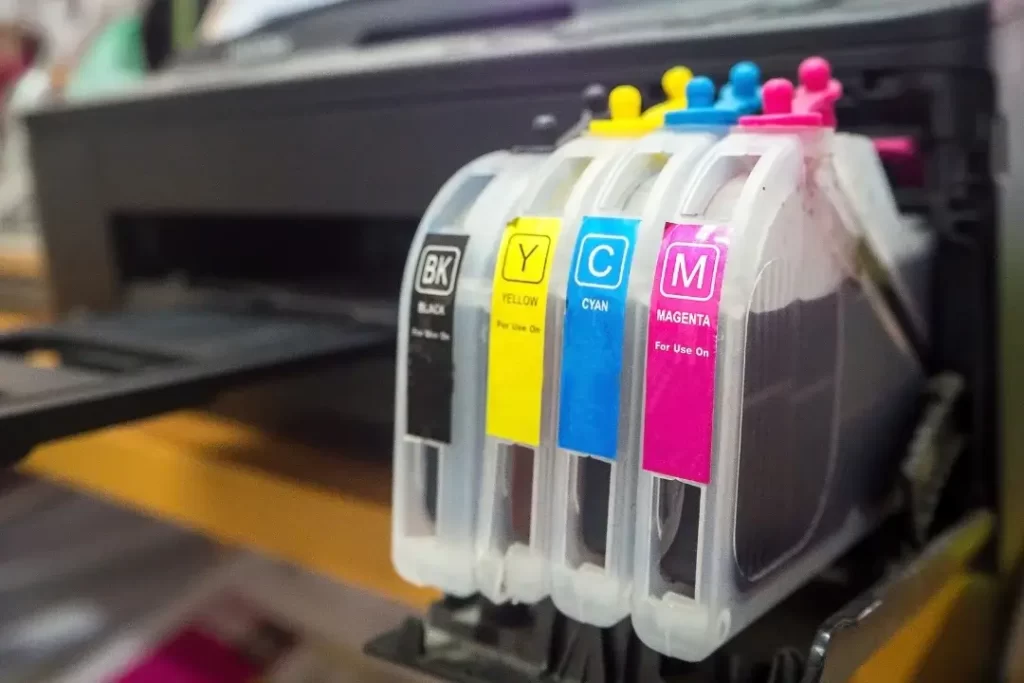
How does dye Sublimation work?
In dye sublimation, the ink is first printed onto transfer paper using a specialized printer with sublimation inks. The transfer paper is then placed on the fabric and subjected to high temperature and pressure, which causes the ink to vaporize and penetrate the fibers of the fabric. As the fabric cools, the ink solidifies and becomes a permanent part of the fabric.
Pros and Cons of Dye Sublimation
Pros:
- Produces high-quality, vibrant designs with excellent color fastness
- Can print on a variety of synthetic fabrics, including polyester, nylon, and spandex
- The designs are durable and long-lasting, even after multiple washings
- Ideal for printing complex designs and photographic images
- Doesn’t leave a noticeable texture on the fabric
Cons:
- Can only be used on synthetic fabrics, not natural fibers like cotton
- Requires specialized equipment and sublimation inks, which can be costly
- Designs can only be printed on white or light-colored fabrics
- The process is not ideal for printing large quantities of t-shirts quickly
Who is Dye Sublimation best for?
Dye sublimation is best for those who want to print high-quality, full-color designs on synthetic fabrics, especially those with intricate or photographic designs. It is popular among sports teams, fitness companies, and businesses that want to create custom t-shirts and other garments with their branding. It is also a great option for those who value durability and want their designs to last a long time.
Price of Dye Sublimation
On average, the cost of dye sublimation printing is around $20 to $30 per shirt, but prices can go up or down depending on many factors.
Heat Transfer Printing/Inkjet
What is Heat Transfer Printing/Inkjet?
Heat Transfer Printing/Inkjet is also one of the different type of t shirt printing where a design is printed onto a transfer paper using a special inkjet printer, and then transferred onto the fabric using heat and pressure. It is a popular method for printing customized t-shirts, as it allows for a high level of detail and vibrant colors.
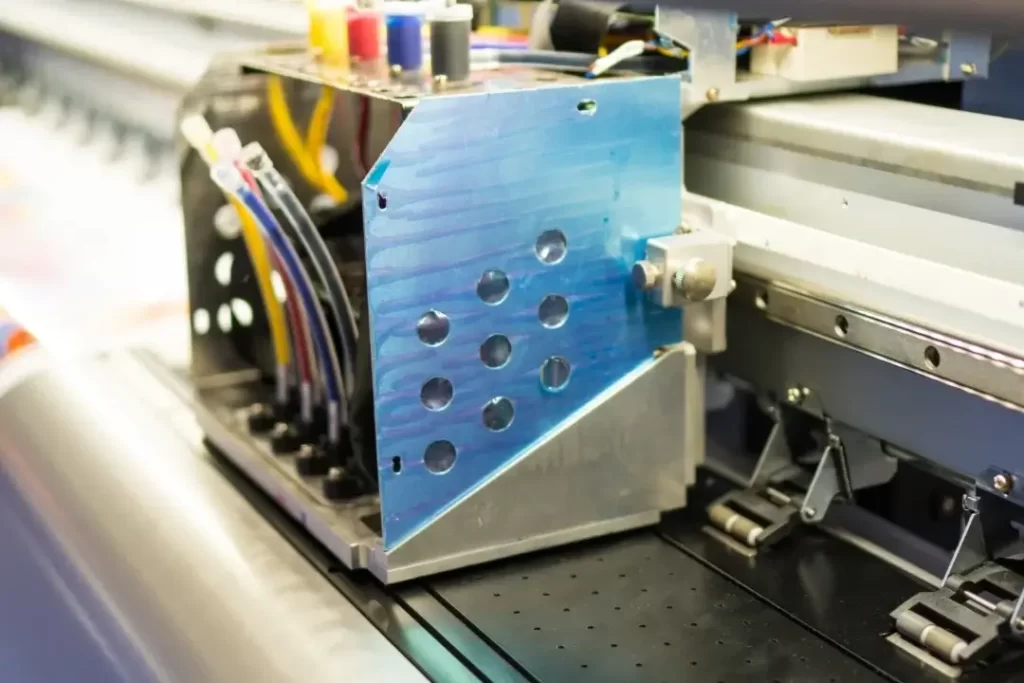
How does Heat Transfer Printing/Inkjet work?
The process of Heat Transfer Printing/Inkjet starts with creating a design on a computer using design software. The design is then printed onto transfer paper using a specialized inkjet printer that is loaded with ink that is formulated to work with transfer paper. The heat transfer paper is then placed onto the fabric, and heat is applied, which transfers the design onto the fabric.
Pros and Cons of Heat Transfer Printing/Inkjet
Pros:
- High level of detail and vibrant colors are possible.
- Low setup costs, making it a cost-effective option for small quantities of t-shirts.
- The printing process is quick and easy, allowing for a fast turnaround time.
Cons:
- Designs may peel or crack over time, especially after multiple washings.
- Heat transfer printing is not suitable for all fabrics, as the transfer may not adhere properly.
- The final product may have a noticeable transfer film, which can feel heavy or stiff.
Who is Heat Transfer Printing/Inkjet best for?
Heat Transfer Printing/Inkjet is best for businesses or individuals who require a small quantity of customized t-shirts with a high level of detail and vibrant colors, and who want to keep setup costs low.
Price of Heat Transfer Printing/Inkjet
The price of Heat Transfer Printing/Inkjet varies depending on the number of t-shirts being printed and the complexity of the design. Generally, it is more cost-effective for smaller quantities of t-shirts, with prices ranging from $5 to $15 per shirt.
Screen Printing
What is Screen Printing?
Screen printing, also commonly known as silk screening, is a popular and widely used method of t-shirt printing. It involves creating a stencil or screen of the design to be printed, which is then placed on top of the fabric. Ink is then pressed through the screen onto the t-shirt, creating a vibrant and long-lasting design.
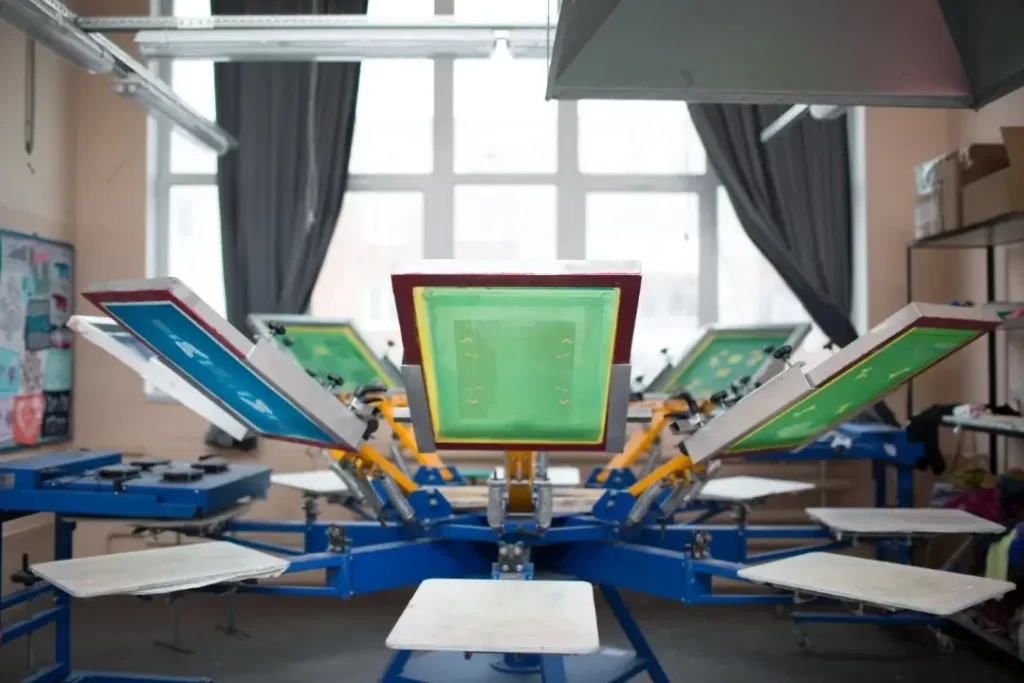
How does Screen Printing work?
Screen printing works by using a stencil or screen, which is a mesh fabric stretched over a frame. The stencil used in screen printing is created by blocking out areas of the screen where the ink should not be applied. The screen is then placed on top of the t-shirt, and ink is applied to the screen using a squeegee. The ink is forced through the stencil and onto the fabric, creating the desired design.
Pros and Cons of Screen Printing
Pros:
- Screen printing is great for creating high-quality, vibrant designs that are long-lasting.
- It’s suitable for printing on a variety of fabrics, including cotton, polyester, and blends.
- Screen printing is cost-effective for large orders, as the more shirts that are printed, the cheaper the cost per shirt becomes.
- Screen printing can produce bold and intricate designs, making it a great choice for detailed graphics.
Cons:
- Screen printing is not as cost-effective for small orders, as the setup process can be time-consuming and expensive.
- Each color in the design requires a separate screen and printing process, which can increase the cost and time required for printing.
- Screen printing is not as flexible as other methods, as each design requires its own screen and setup process.
Who is Screen Printing best for?
Screen printing is a great choice for businesses and organizations that need to print a large number of shirts with the same design. It’s also a great choice for creating high-quality, long-lasting t-shirt designs. Screen printing is an ideal choice for designs with few colors and large, bold graphics.
Price of Screen Printing
The price of screen printing varies depending on factors such as the number of shirts being printed, the complexity of the design, and the number of colors in the design. As a general rule, screen printing becomes more cost-effective as the number of shirts being printed increases. For example, printing 100 shirts with a one-color design may cost around $5-$10 per shirt, while printing 500 shirts with the same design may cost around $2-$5 per shirt. It’s important to note that prices can vary widely depending on the specific details of the order, so it’s best to request a quote from a screen printing provider.
Airbrushing
What is Airbrushing?
Airbrushing is a type of t-shirt printing technique where a small air-operated tool called an airbrush is used to spray paint onto the fabric. It creates a smooth and even application of paint, resulting in a professional-looking design. Airbrushing is a popular method for creating unique and detailed designs on t-shirts.

How does Airbrushing work?
In airbrushing, the paint is loaded into the airbrush and then sprayed onto the fabric. The airbrush uses compressed air to atomize the paint, breaking it down into tiny droplets, which are then sprayed onto the fabric. The artist can control the spray pattern and the amount of paint used to achieve the desired effect. Once the design is complete, the fabric is heat-set to permanently bond the paint to the fabric.
Pros and Cons of Airbrushing
Pros:
- Airbrushing allows for intricate and detailed designs that are difficult to achieve with other printing techniques.
- The paint used in airbrushing is flexible and moves with the fabric, making it durable and long-lasting.
- Airbrushing can be used on a variety of fabrics, not just t-shirts.
- Each airbrushed design is unique and one-of-a-kind.
Cons:
- Airbrushing can be time-consuming and requires skill and practice to achieve the desired effect.
- The cost of airbrushing can be higher than other printing techniques due to the amount of time and skill required.
- Airbrushing can be messy and require a well-ventilated area to prevent inhalation of fumes.
- It may not be the best option for large production runs due to the time and effort required for each individual design.
Who is Airbrushing best for?
Airbrushing is best for individuals or businesses who want a unique and custom design on their t-shirts. It is especially popular in the fashion and music industries, where individuality and creativity are highly valued. Airbrushing is also a great option for those who want a design that is not easily achievable with other printing techniques.
Price of Airbrushing
Prices can range from $25 to $100 per shirt. It’s important to note that airbrushing is a specialized technique, so it may be more expensive than other printing methods. However, the end result is a custom and unique design that is sure to impress.
Discharge Printing
What is Discharge Printing?
Discharge printing is a unique type of printing that involves removing the dye from a colored garment to create a natural, “bleached” effect. It is commonly used on dark-colored garments to achieve a more subtle, vintage look. Discharge printing works by using a chemical compound that interacts with the dye in the fabric, neutralizing it and creating a lighter area.
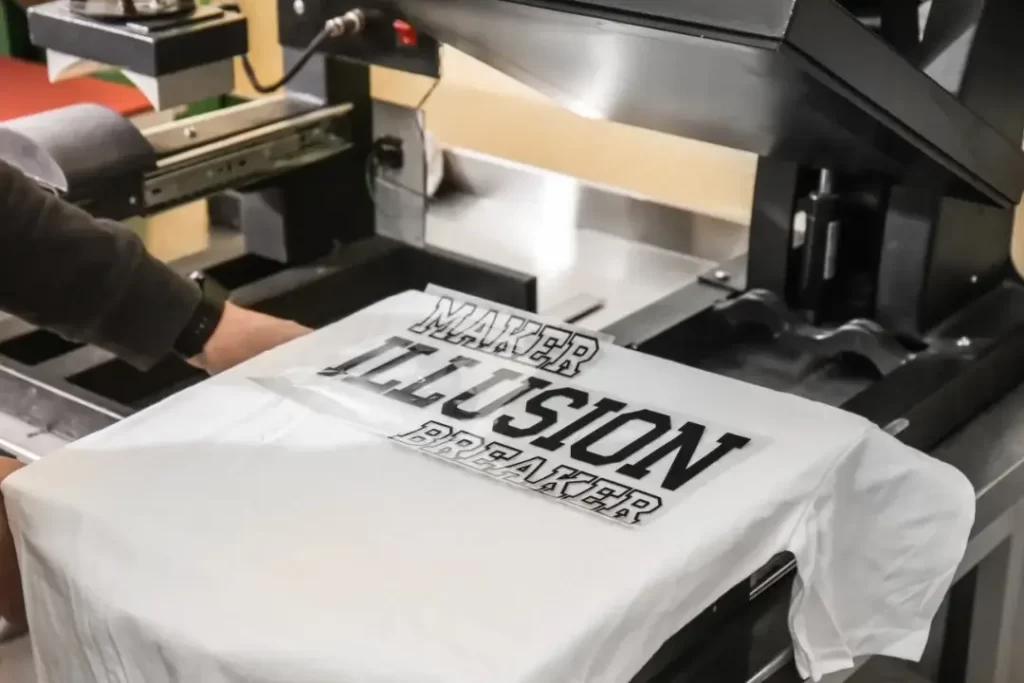
How does Discharge Printing work?
Discharge printing works by using a specialized ink that contains a discharge agent. The discharge agent removes the dye from the garment and replaces it with the ink color, resulting in a natural, soft hand feel. The process involves applying the discharge ink onto the fabric and then curing it at high temperatures to activate the discharge agent.
Pros and Cons of Discharge Printing
Pros:
- Creates a natural, soft hand feel
- Ideal for achieving a vintage, “worn” look
- Great for designs with fine details and small text
- Environmentally friendly as it uses water-based inks
Cons:
- Limited color options, as the process only works on dark-colored fabrics
- Can be unpredictable as the outcome depends on the dye used in the fabric
- Requires a high level of expertise and equipment to achieve a consistent result
- Can be more expensive than other printing methods due to the specialized ink and equipment needed
Who is Discharge Printing best for?
Discharge printing is best type of t shirt printing for those looking for a unique, vintage look on dark-colored garments. It is a great option for brands that prioritize eco-friendliness and want to use water-based inks. It is also ideal for designs with fine details and small text that may be difficult to achieve with other printing methods.
Price of Discharge Printing
On average, discharge printing can range from $4-$8 per garment.
Conclusion
In conclusion, when it comes to choosing the best type of printing for t shirts, it ultimately depends on your specific needs and preferences. Here are some key takeaways:
- Screen printing is great for large quantity orders and designs with few colors.
- Direct-to-garment printing is ideal for full-color designs and small-batch orders.
- Sublimation printing isbest type of print for t shirts with synthetic fabrics and all-over designs.
- Heat transfer vinyl is a versatile option for smaller quantities and personalized designs.
- Heat press printing allows for custom designs with a professional finish.
- Discharge printing creates a soft, vintage look and feel.
Consider factors such as the number of shirts, design complexity, fabric type, and budget when making your decision. With the information provided, you can make an informed decision on all types of t shirt printing that will best suit your needs.
Frequently Asked Questions
Screen printing is often the best choice for small businesses due to its versatility and cost-effectiveness.
Direct-to-garment printing works best on 100% cotton fabrics but can also be used on blends with a high cotton content.
Heat transfer vinyl can be durable and long-lasting if applied correctly and cared for properly.
Consider the level of detail in your design, the fabric you will be printing on, and your budget to determine the best printing method for your needs.
Screen printing is not the best choice for printing photographs on a t-shirt. Consider using digital printing or direct-to-garment printing instead.
Yes, water-based inks and eco-friendly dyes are available for screen printing and direct-to-garment printing.
Discharge printing works best on light-colored fabrics but can also be used on dark-colored fabrics with the addition of a discharge under base.
It is possible to print on a t-shirt using a home printer and transfer paper, but the results may not be as durable as professional printing methods.
The cost of printing a custom t-shirt depends on factors such as the printing method used, the number of shirts ordered, and the complexity of the design.
Heat press printing can be used to print on various parts of a t-shirt, such as the front, back, and sleeves, as long as the heat press machine can accommodate the size and shape of the garment.
Typically, heat transfer paper or screen printing paper is used for t-shirt printing. Heat transfer paper is used for digital printing, while screen printing paper is used for traditional screen printing methods. The choice of paper will depend on the printing method used and the desired result.


CONTACT US
Fill up the form so we can contact and help you with all your related queries.
Email Us
info@expertowears.com

